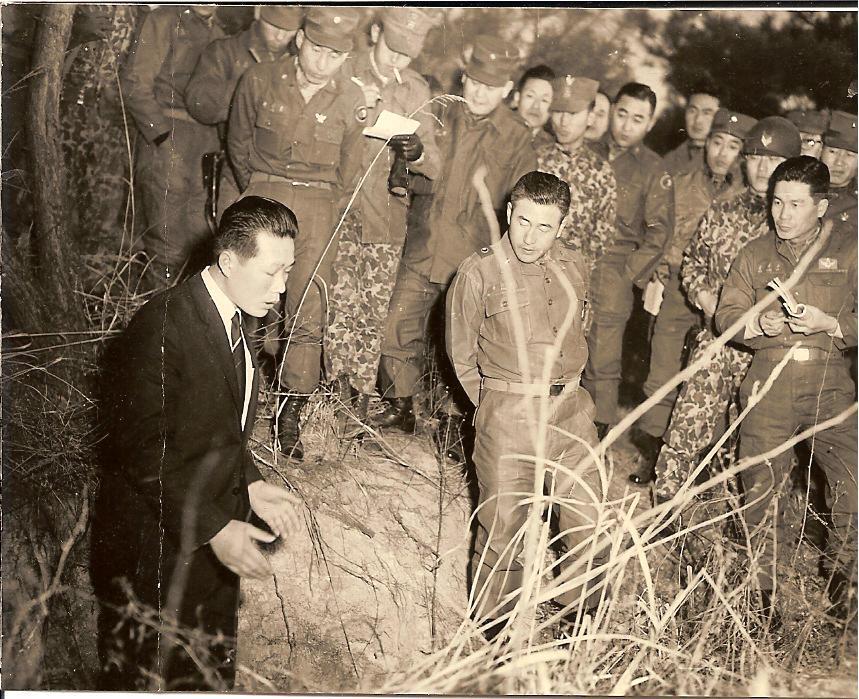Lt. Kim Shin-jo was part of a 31-member team of North Korean commandos, Unit 124, who were sent by the supreme leader and founder of North Korea, Kim Il Sung, to assassinate South Korean president Park Chung-hee. The year was 1968.
The team of commandos, exhausted from their covert mission across the border, ran into some woodcutters in a forest clearing. Despite the team being dressed in South Korean army uniform, the workers were suspicious. When they asked them if they were from the North, Kim replied, “We are here to liberate you and bring communism to South Korea.”
“I was in charge of the assault element, which would secure the first floor, allowing the rest of the team to proceed upstairs and kill Park,” another member of the team, Lt. Kim Shin-jo, said in an interview with NBC News on the 50th anniversary of the fateful day that he crossed the Demilitarized Zone into South Korea.
“It had to be a short-term war,” Mr Kim told the South China Morning Post. “In the Korean war, North Korea could not win due to lack of money, lack of resources. The strategy was to win before US aircraft from Okinawa could arrive. It had to be a swift, asymmetrical attack.”
Now with their cover blown, Kim and his team decided that their only option was to kill the workmen and bury their bodies. But there was a problem – the ground was frozen solid in the harsh winter conditions.
So, Captain Kim drew up a contract, lecturing the group on the values of communism, and asked them to “join the revolution or die.” The woodcutters signed the document and were released by the group. They headed to the nearest South Korean army post and reported the encounter with Unit 124.
“They blocked the roads, but they could not stop us,” Kim told SCMP. “They thought we would move at 8km/h, but we moved at 12km/h. They blocked the roads behind us: We had already passed through.”
At this time, North Korea was arguably in a stronger military and economic position compared to its Southern neighbor. Plus, America’s preoccupation with Vietnam gave the North a timely opportunity to attempt to reunite the Korean landmass.
Unit 124 pushed on with their mission. Now dressed in civilian clothes and draped in trench coats to hide their sub-machine guns and grenades, the team were being hotly pursued by the South Korean military. The group dodged patrols and walked through checkpoints. They were now just 350 yards away from the Blue House presidential residence. “We were confident,” recalled Mr Kim. “We knew all about the Blue House defence; we didn’t think much of their bodyguards.”

Finally, the commandos were stopped by a police chief who drew his pistol and demanded to see what was under their coats. Another of the North Korean operatives opened fire, killing the chief. An intense firefight broke out between the North Korean commandos and the heavily armed Capital Garrison Command protecting the presidential residence.
By the time the battle had ended, almost 100 people were dead, including civilians who had been caught up in the crossfire. With South Korean reinforcements flooding in from every direction, the commando team knew their mission to assassinate the President had become impossible to complete. Captain Kim ordered a retreat, and the team split up.
But Kim Shin-jo knew that fleeing back to North Korea was a futile exercise. “I thought, first of all, I want to live,” Kim Shin-jo told NBC. “If I die after killing Park Chung-hee, then I’ve fulfilled my duty,” Kim Shin-jo said he remembered thinking. “But if I don’t kill Park Chung-hee, why should I die?”
Eventually, he was captured by South Korean forces. All but one of his team had been killed by the military as they fought to the death.
But Kim Shin-jo’s willingness to surrender, and the revelation that he never fired his weapon at the South Korean’s, came at a horrific price to his family.
“If I had fired my weapon alongside my comrades, and if I had gotten a life sentence or the death penalty, I would have been deemed a revolutionary. But because I raised my hands because I wanted to live, I pledged my allegiance to South Korea,” Kim Shin-jo said.
“I was deemed a defector, and they executed my family.”
South Korea, however, welcomed him in. His willingness to co-operate with the investigation into the North Korean plot made him a very popular man there. In fact, despite being part of the commando team that was tasked with assassinating the President, he was given just a couple of years in prison.

When he was released in 1970, Kim met a woman who had been his pen pal since he had been taken in by the authorities. He was so concerned about backlash from North Korea that he had her investigated to make sure she was not a North Korean secret agent. She wasn’t, and the two fell in love. What is even more incredible is that she was a passionate follower of Jesus, and she converted Kim to the Christian faith.
Kim is now the pastor of a megachurch in Seoul, South Korea. Now 76-years-old, Kim still struggles with the decisions he made that cost the lives of his entire family, even if it was 50 years ago now.
I lived, but my heart aches when I think about my parents and my siblings who I left behind,” he said. “This is something I have to carry with me to my grave.”
“I pray for both countries.”



